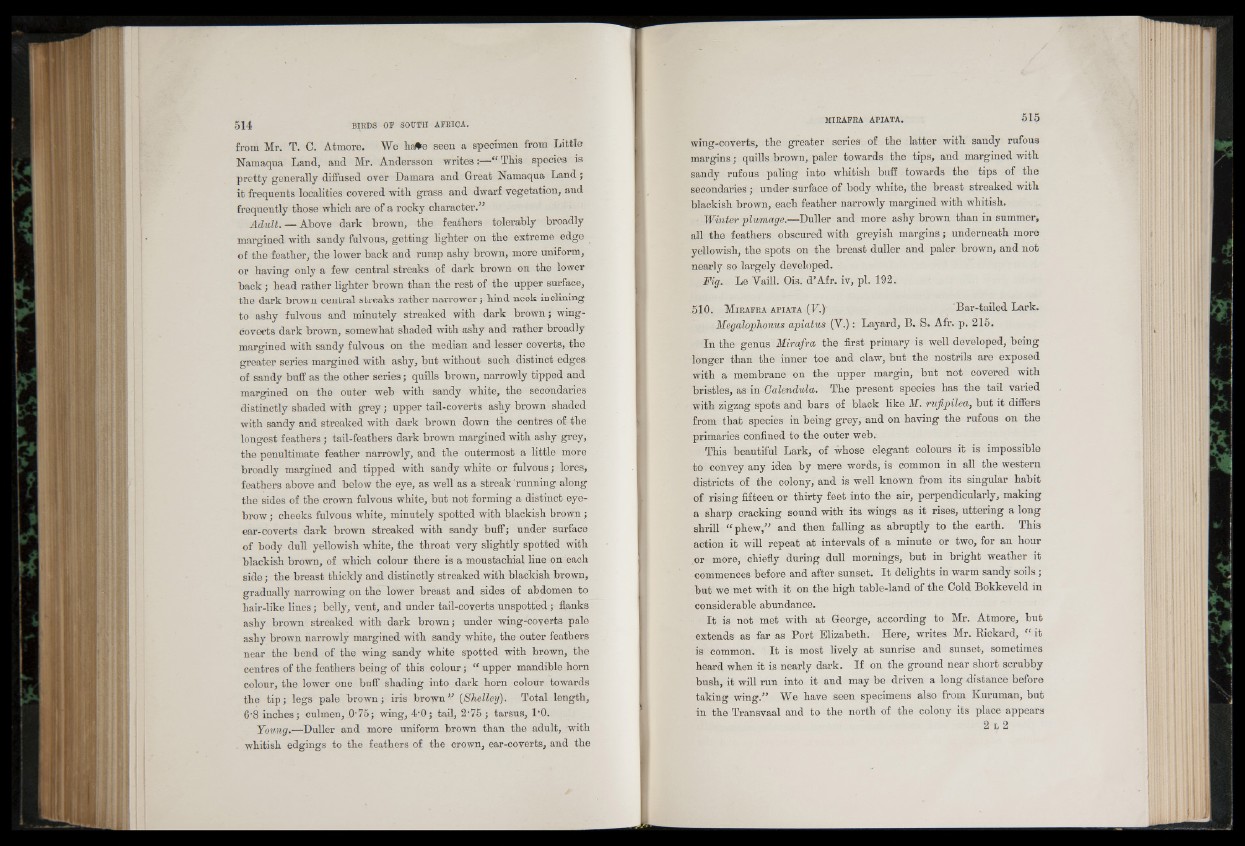
from Mr. T. C. Atmore. We ha*e seen a specimen from Little
Namaqua Land, and Mr. Andersson writes:—“ This species is
pretty generally diffused over Damara and Great Namaqua Land ;
it frequents localities covered with grass and dwarf vegetation, and
frequently those which are of a rocky character.”
Adult. — Above dark brown, the feathers tolerably broadly
margined with sandy fulvous, getting lighter on the extreme edge
of the feather, the lower back and rump ashy brown, more uniform,
or having only a few central streaks of dark brown on the lower
back ; head rather lighter brown than the rest of the upper surface,
the dark brown central streaks rather narrower; hind neck inclining
to ashy fulvous and minutely streaked with dark brown; wing-
coverts dark brown, somewhat shaded with ashy and rather broadly
margined with sandy fulvous on the median and lesser coverts, the
greater series margined with ashy, but without such distinct edges
of sandy buff as the other series; quills brown, narrowly tipped and
margined on the outer web with sandy white, the secondaries
distinctly shaded with grey; upper tail-coverts ashy brown shaded
with sandy and streaked with dark brown down the centres of the
longest feathers ; tail-feathers dark brown margined with ashy grey,
the penultimate feather narrowly, and the outermost a little more
broadly margined and tipped with sandy white or fulvous; lores,
feathers above and below the eye, as well as a streak running along
the sides of the crown fulvous white, but not forming a distinct eyebrow
; cheeks fulvous white, minutely spotted with blackish brown;
ear-coverts dark brown streaked with sandy buff; under surface
of body dull yellowish white, the throat very slightly spotted with
blackish brown, of which colour there is a moustachial line on each
side; the breast thickly and distinctly streaked with blackish brown,
gradually narrowing on the lower breast and sides of abdomen to
hair-like lines; belly, vent, and under tail-coverts unspotted; flanks
ashy brown streaked with dark brown; under wing-coyerts pale
ashy brown narrowly margined with sandy white, the outer feathers
near the bend of the wing sandy white spotted with brown, the
centres of the feathers being of this colour; “ upper mandible horn
colour, the lower one buff shading into dark horn colour towards
the tip; legs pale brown; iris brown” {Shelley). Total length,
6'8 inches; culmen, 0'75; wing, 4’0; tail, 2'75; tarsus, l'O.
Young.—Duller and more uniform brown than the adult, with
whitish edgings to the feathers of the crown, ear-coverts, and the
wing-coverts, the greater series of the latter with sandy rufous
margins; quills brown, paler towards the tips, and margined with
sandy rufous paling into whitish buff towards the tips of the
secondaries ; under surface of body white, the breast streaked with
blackish brown, each feather narrowly margined with whitish.
Winter plumage.—Duller and more ashy brown than in summer,
all the feathers obscured with greyish margins; underneath more
yellowish, the spots on the breast duller and paler brown, and not
nearly so largely developed.
Fig. Le Vaill. Ois. d’Afr. iv, pi. 192.
510. M irafra a p ia ta (F.)~ Bar-tailed Lark.
Megalophonus apiatus (V.): Layard, B. S. Afr. p. 215.
In the genus Mirafra the first primary is well developed, being
longer tlmn the inner toe and claw, but the nostrils are exposed
with a membrane on the upper margin, but not covered with
bristles, as in Calendula. The present species has the tail varied
with zigzag spots and bars of black like M. rufipilea, but it differs
from that species in being grey, and on having the rufous on the
primaries confined to the outer web.
This beautiful Lark, of whose elegant colours it is impossible
to convey any idea by mere words, is common in all the western
districts of the colony, and is well known from its singular habit
of rising fifteen or thirty feet into the air, perpendicularly, making
a sharp cracking sound with its wings as it rises, uttering a long
shrill “ phew,” and then falling as abruptly to the earth. This
action it will repeat at intervals of a minute or two, for an hour
or more, chiefly during dull mornings, but in bright weather it
commences before and after sunset. I t delights in warm sandy soils;
but we met with it on the high table-land of the Cold Bokkeveld in
considerable abundance.
It is not met with at George, according to Mr. Atmore, but
extends as far as Port Elizabeth. Here, writes Mr. Rickard, “ it
is common. It is most lively at sunrise and sunset, sometimes
heard when it is nearly dark. If on the ground near short scrubby
bush, it will run into it and may be driven a long distance before
taking wing.” "We have seen specimens also from Ivuruman, but
in the Transvaal and to the north of the colony its place appears
2 l 2